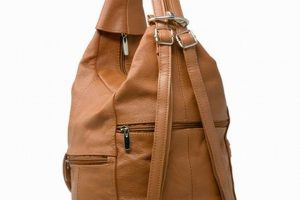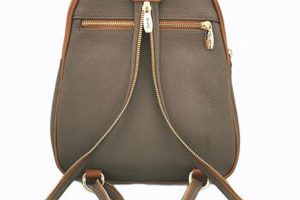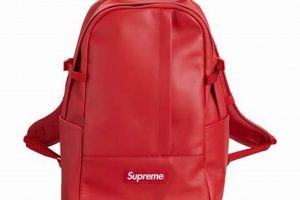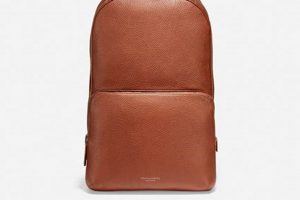Items designed to carry belongings on the back, crafted from materials intended to mimic the look and feel of animal-derived leather, but are instead produced from sources such as polyurethane (PU), polyvinyl chloride (PVC), apple leather, pineapple leaf fiber (Piatex), mushroom leather, or other plant-based and synthetic alternatives. These articles serve the same functional purpose as traditional leather backpacks, offering storage and portability for various items. As an example, a student might use one to transport textbooks and a laptop.
These items offer several potential advantages. From an ethical standpoint, they provide an alternative to animal-derived products. Environmentally, some materials used in their construction may have a smaller carbon footprint compared to the production of genuine leather, depending on the specific manufacturing processes and materials involved. Historically, the development of these alternative materials has been driven by increasing awareness of animal welfare and environmental concerns.
The subsequent sections will delve deeper into the different materials used in the construction of these items, explore their durability and environmental impact, and offer guidance on selecting a suitable product based on individual needs and preferences.
Guidance on Selection and Maintenance
The following points offer practical advice for those considering the purchase and care of backpacks constructed from non-animal derived leather alternatives.
Tip 1: Material Assessment: Prioritize understanding the specific material used in the backpack’s construction. Polyurethane (PU) and Polyvinyl Chloride (PVC) are common, but differ in durability and environmental impact. Plant-based options, such as Piatex or apple leather, offer a more sustainable alternative, but may require different care.
Tip 2: Durability Considerations: Evaluate the intended use. For heavy loads and frequent use, reinforce stitching, high-denier fabrics, and abrasion-resistant materials are crucial. Lower-priced products might sacrifice durability for affordability.
Tip 3: Weather Resistance: Consider the backpack’s ability to withstand moisture. While some materials are naturally water-resistant, others may require a water-repellent coating or lining to protect contents from rain or spills.
Tip 4: Cleaning Protocols: Implement appropriate cleaning methods based on the material. Generally, a damp cloth and mild soap are suitable for surface cleaning. However, avoid harsh chemicals or abrasive cleaners that can damage the material’s finish.
Tip 5: Storage Practices: When not in use, store the backpack in a cool, dry place away from direct sunlight. This prevents the material from drying out, cracking, or fading over time.
Tip 6: Hardware Inspection: Regularly examine zippers, buckles, and straps for signs of wear or damage. Promptly repair or replace any compromised components to maintain the backpack’s functionality and longevity.
Tip 7: Ethical Sourcing: Research brands that prioritize transparent and ethical sourcing of materials. Look for certifications or statements that confirm the absence of harmful chemicals and adherence to fair labor practices.
By carefully considering these factors, individuals can make informed decisions that align with their needs, values, and commitment to sustainable consumption. Proper maintenance will further extend the lifespan of the chosen backpack, maximizing its utility and minimizing its environmental impact.
The subsequent section will address frequently asked questions about these products, providing further clarity on their properties, performance, and long-term value.
1. Material Composition
The core characteristic differentiating these backpacks from their traditional counterparts lies in their material composition. This facet dictates not only the aesthetic properties, mirroring or diverging from genuine leather, but also the functional aspects, including durability, water resistance, and environmental impact. The materials employed range from polyurethane (PU) and polyvinyl chloride (PVC), which are petroleum-based synthetics, to more sustainable alternatives such as pineapple leaf fiber (Piatex), apple leather, mushroom leather, and recycled plastics. The selection of the material determines the product’s lifespan, its ability to withstand wear and tear, and its contribution to environmental degradation or sustainability. For instance, a backpack constructed from recycled PET bottles diverts waste from landfills and reduces the demand for virgin plastic, directly impacting the environmental footprint.
The practical significance of understanding the material composition extends beyond mere aesthetics or ethical considerations. It directly affects the backpack’s performance in various conditions. PU and PVC, while offering affordability, may lack breathability and can crack or peel over time, particularly under exposure to extreme temperatures or sunlight. Conversely, plant-based options, while more environmentally friendly, may require specialized care and may not be as resistant to abrasion as their synthetic counterparts. The choice of lining materials, such as recycled nylon or organic cotton, further contributes to the overall environmental profile and functional properties. Therefore, a consumer seeking a durable, weather-resistant backpack for outdoor use would necessitate a different material composition than someone prioritizing a lightweight, fashion-forward option for urban commuting.
In conclusion, material composition is the defining element of these backpacks, shaping their performance, environmental impact, and ethical standing. While the term “vegan leather” serves as an umbrella term, the specific materials employed dictate the backpack’s suitability for various applications and its contribution to a more sustainable future. Understanding the nuances of each material empowers consumers to make informed decisions aligned with their individual needs and values, ultimately driving the demand for more innovative and environmentally responsible manufacturing practices within the backpack industry. Challenges remain in achieving consistent quality and durability across all alternative materials, requiring ongoing research and development to fully realize their potential as viable replacements for traditional leather.
2. Ethical Sourcing
Ethical sourcing, in the context of vegan leather backpacks, centers on the responsible procurement of materials and manufacturing practices throughout the supply chain. A primary driver for the increasing adoption of such backpacks is the ethical concern surrounding animal welfare, specifically the treatment of animals in the leather industry. However, simply opting for a non-animal material does not automatically guarantee an ethically sound product. The ethical dimension extends to encompass labor practices, environmental impact, and the use of potentially harmful chemicals in the production process. Therefore, the connection between ethical sourcing and these backpacks is one of intended alignment, requiring careful evaluation beyond the mere avoidance of animal products. A real-world example highlighting the importance of ethical sourcing would be a company transparently disclosing its factory conditions, ensuring fair wages and safe working environments for its employees. The practical significance of understanding this connection lies in enabling consumers to make informed purchasing decisions, supporting brands that genuinely prioritize ethical practices and contributing to a more responsible and sustainable industry.
Further analysis reveals that the ethical landscape surrounding these backpacks is complex. While plant-based materials offer an alternative to animal-derived leather, their cultivation can also raise ethical questions related to land use, water consumption, and the potential use of pesticides. Similarly, synthetic materials like PU and PVC, while avoiding animal products, are often derived from fossil fuels and may involve the use of toxic chemicals in their production. The responsible selection of suppliers who adhere to fair labor standards, minimize environmental impact, and utilize safer chemical alternatives becomes paramount. Practical applications of this understanding include scrutinizing certifications such as Fair Trade or GOTS (Global Organic Textile Standard), which provide independent verification of ethical and environmental standards. Consumers can also research brands’ sustainability reports and engage in direct communication to ascertain their commitment to ethical sourcing principles.
In conclusion, the ethical dimension of these backpacks extends far beyond the simple avoidance of animal leather. Ethical sourcing encompasses a holistic approach that considers labor practices, environmental impact, and the use of chemicals throughout the entire supply chain. Key insights involve the need for transparency, traceability, and independent verification to ensure that products genuinely align with ethical values. Challenges persist in navigating the complexities of global supply chains and verifying the claims made by manufacturers. However, by prioritizing ethical sourcing, consumers can contribute to a more sustainable and responsible industry, driving positive change and promoting a future where both animal welfare and human rights are respected. This commitment links directly to the broader theme of conscious consumption and its potential to transform industries toward more ethical and sustainable practices.
3. Durability
Durability represents a critical factor in the assessment and selection of vegan leather backpacks. It directly influences the longevity of the product, its ability to withstand daily use, and its overall value proposition. The material composition, construction techniques, and intended application collectively determine the durability characteristics of these backpacks.
- Material Resistance to Abrasion
The abrasion resistance of the vegan leather material is paramount. Synthetic materials like PU and PVC may vary significantly in their ability to withstand scuffs, scratches, and general wear and tear. Plant-based alternatives, such as Pinatex or mushroom leather, possess differing resistance levels, influenced by their inherent fiber structure and any applied coatings. A backpack used frequently for commuting or outdoor activities requires a material with a high abrasion resistance to maintain its aesthetic appeal and structural integrity over time.
- Seam Strength and Stitching Quality
The strength of the seams and the quality of the stitching directly impact the backpack’s ability to carry weight and withstand stress. Reinforced stitching, particularly at stress points such as straps and attachment points, is crucial. Weak seams can lead to tearing and eventual failure of the backpack, rendering it unusable. The type of thread used and the density of stitches per inch contribute to the overall seam strength.
- Resistance to Environmental Factors
Exposure to environmental factors such as sunlight, moisture, and temperature fluctuations can degrade vegan leather materials. Prolonged exposure to UV radiation can cause fading and cracking, while excessive moisture can lead to delamination or mold growth. Materials that are treated with water-resistant coatings or stabilizers exhibit enhanced durability in various environmental conditions. A backpack intended for use in diverse climates necessitates resistance to a range of environmental stressors.
- Hardware Quality and Longevity
The quality of zippers, buckles, and other hardware components significantly impacts the overall durability of the backpack. Inferior hardware can break or malfunction, compromising the functionality of the backpack even if the vegan leather material itself remains intact. Corrosion-resistant hardware is essential for prolonged use, particularly in humid environments. A robust and reliable hardware selection complements the material’s durability, ensuring a long-lasting product.
In conclusion, the durability of vegan leather backpacks is a multifaceted attribute encompassing material resistance, construction quality, environmental resilience, and hardware integrity. Careful consideration of these factors is essential when selecting a backpack that meets specific needs and intended use. Comparative analysis of different materials and construction techniques allows for informed purchasing decisions that prioritize longevity and value. Enhanced durability contributes to a reduction in waste and supports sustainable consumption practices.
4. Weather Resistance
Weather resistance, in the context of vegan leather backpacks, denotes the capacity of the material and construction to withstand exposure to various environmental elements, primarily moisture, ultraviolet (UV) radiation, and temperature fluctuations. This characteristic directly affects the backpack’s ability to protect its contents from damage and to maintain its structural integrity and aesthetic appearance over time. The correlation between weather resistance and backpack functionality is causal; inadequate resistance leads to water damage to electronic devices or paper documents, accelerated material degradation, and ultimately, a reduced lifespan of the product. The importance of weather resistance as a component of a backpack is heightened for individuals who commute in inclement weather, engage in outdoor activities, or reside in regions with high humidity or frequent rainfall. For instance, a student carrying a laptop in a non-weather-resistant backpack risks irreversible damage to the device during a sudden downpour.
Further analysis reveals that achieving weather resistance in these backpacks involves a combination of material selection, construction techniques, and protective treatments. While some vegan leather alternatives inherently possess a degree of water resistance, such as certain coated polyurethanes, others require specialized coatings or laminations to enhance their protective capabilities. Seam sealing, where the seams are treated to prevent water penetration, represents a crucial construction technique. Furthermore, the use of water-resistant zippers and closures contributes significantly to overall weather protection. The practical application of this understanding manifests in the selection of backpacks featuring waterproof linings, reinforced seams, and durable water repellent (DWR) finishes. These features collectively mitigate the risk of water damage and extend the usability of the backpack across diverse weather conditions. For example, a backpack designed for hiking might incorporate a waterproof rain cover that can be deployed in heavy rainfall to provide an additional layer of protection.
In conclusion, weather resistance is a pivotal attribute for vegan leather backpacks, impacting their functionality, durability, and ability to safeguard valuable contents. Key insights underscore the importance of material properties, construction methods, and protective treatments in achieving effective weather protection. Challenges persist in balancing weather resistance with other desirable qualities, such as breathability and aesthetic appeal. The broader theme connects to the growing consumer demand for versatile and reliable products that perform consistently in varying environmental conditions. By prioritizing weather resistance, consumers can ensure that their backpacks provide long-lasting protection and utility, regardless of the weather.
5. Design Aesthetics
Design aesthetics play a crucial role in the appeal and market acceptance of vegan leather backpacks. Visual appearance, tactile qualities, and overall design language influence consumer perception and contribute significantly to purchase decisions. These aesthetic elements are not merely superficial; they communicate information about the product’s quality, intended use, and the values of both the manufacturer and the consumer.
- Mimicry of Natural Leather Textures and Finishes
One key aspect of design aesthetics involves replicating the look and feel of genuine leather. Manufacturers employ various techniques to simulate natural grain patterns, textures, and finishes. This includes embossing, printing, and specialized coating processes. The success of this mimicry directly impacts the perceived value and desirability of the backpack. For instance, a backpack with a convincing leather-like texture might be perceived as more luxurious and sophisticated than one with a plainly synthetic appearance.
- Color Palette and Hardware Choices
The selection of colors and hardware significantly contributes to the overall aesthetic. Neutral tones, such as browns, blacks, and tans, often evoke a classic and timeless appeal. However, brighter colors and unconventional hardware designs can create a more modern and edgy aesthetic. The choice of zippers, buckles, and other metal components, including their finish (e.g., matte, polished), influences the perceived quality and style. A backpack with high-quality, aesthetically pleasing hardware communicates attention to detail and craftsmanship.
- Form Factor and Silhouette
The overall shape and profile of the backpack contribute significantly to its design aesthetics. Sleek, minimalist designs are often associated with contemporary styles, while more structured and utilitarian forms may appeal to those seeking functionality and practicality. The arrangement of pockets, straps, and other features also influences the visual balance and aesthetic appeal. A well-proportioned and thoughtfully designed silhouette enhances the backpack’s overall attractiveness.
- Branding and Embellishments
Branding elements, such as logos and labels, as well as decorative embellishments, such as stitching patterns and embossed details, contribute to the overall design aesthetics and brand identity. Subtle and understated branding often conveys a sense of sophistication, while more prominent branding can create a bold and recognizable statement. The placement and execution of these elements impact the perceived value and desirability of the backpack. A tastefully branded backpack can enhance its aesthetic appeal and contribute to brand recognition.
In conclusion, design aesthetics are integral to the success of vegan leather backpacks. By carefully considering factors such as texture, color, form, and branding, manufacturers can create products that appeal to a wide range of consumers and effectively communicate their brand values. These aesthetic considerations, combined with ethical and functional attributes, contribute to the growing popularity and acceptance of these backpacks in the marketplace.
6. Carrying Capacity
Carrying capacity, in the context of vegan leather backpacks, refers to the maximum volume and weight of items that the backpack can safely and effectively accommodate. It is a critical attribute that directly impacts the functionality and usability of the product. A backpack’s carrying capacity must align with the user’s intended needs to ensure comfortable and efficient transport of belongings.
- Volume and Dimensions
The internal volume, typically measured in liters, dictates the amount of space available for storage. The backpack’s dimensions influence the size and shape of items that can be accommodated. For example, a backpack with a large volume but narrow dimensions may be suitable for carrying clothing or soft goods, but less ideal for bulky items like textbooks or electronic devices. The intended use case dictates the optimal volume and dimensions.
- Weight Distribution and Support
Effective weight distribution is essential for comfortable carrying, especially when the backpack is fully loaded. Features such as padded shoulder straps, sternum straps, and hip belts distribute weight evenly across the body, reducing strain on the shoulders and back. Internal frames or reinforced back panels provide structural support, preventing the backpack from sagging or deforming under heavy loads. The design and construction of the support system directly impact the user’s comfort and posture.
- Compartmentalization and Organization
The arrangement and number of compartments and pockets influence the organization and accessibility of items within the backpack. Multiple compartments allow for separating different types of items, such as books, electronics, and personal belongings. Dedicated pockets for specific items, such as laptops or water bottles, enhance convenience and prevent damage. Efficient compartmentalization maximizes the usable space and promotes organized packing.
- Material Strength and Load-Bearing Capacity
The strength of the vegan leather material and the construction of the backpack determine its load-bearing capacity, which is the maximum weight the backpack can safely carry without tearing or failing. Reinforced stitching, durable zippers, and robust hardware components contribute to the overall load-bearing capacity. Exceeding the load-bearing capacity can damage the backpack and potentially injure the user. The material’s tensile strength and the integrity of the seams are critical factors in determining the maximum safe load.
These facets collectively define the carrying capacity of vegan leather backpacks. They determine its suitability for various purposes, from daily commuting to extended travel. Manufacturers must carefully consider these factors to design backpacks that meet the diverse needs of consumers. Selection of vegan leather backpacks should prioritize carrying capacity as it links directly to the main point, ensuring users have effective product in terms of volume, dimensions and weight they put into it.
7. Environmental Impact
The environmental impact associated with backpacks crafted from vegan leather alternatives is a multifaceted issue, encompassing resource consumption, pollution generation, and waste disposal. The selection of materials and manufacturing processes directly influences the ecological footprint of these products. The primary motivation for utilizing these alternatives stems from concerns regarding the environmental consequences of traditional leather production, including deforestation for cattle ranching, high water usage in tanning processes, and the release of harmful chemicals into the environment. The importance of assessing the environmental impact of vegan leather backpacks lies in determining whether these alternatives genuinely offer a more sustainable solution or merely shift the environmental burden to different aspects of the production lifecycle. A prominent example involves comparing the carbon footprint of a backpack made from recycled PET bottles versus one made from PVC, highlighting the trade-offs between material origin and manufacturing emissions. The practical significance of this understanding resides in enabling consumers to make informed choices that minimize their environmental impact and support responsible manufacturing practices.
Further analysis reveals that the environmental impact varies considerably depending on the specific materials and production methods employed. Plant-based alternatives, such as Piatex (pineapple leaf fiber) or mushroom leather, may reduce reliance on fossil fuels and decrease chemical pollution. However, their cultivation and processing can also entail environmental concerns related to land use, water consumption, and pesticide application. Conversely, synthetic materials like polyurethane (PU) and polyvinyl chloride (PVC), derived from petroleum, contribute to greenhouse gas emissions during production and pose challenges for end-of-life disposal due to their limited biodegradability. The responsible sourcing of materials, the implementation of closed-loop manufacturing processes, and the adoption of eco-friendly dyes and finishes represent practical applications aimed at mitigating the environmental impact. For instance, a company might invest in renewable energy sources to power its manufacturing facilities or partner with recycling programs to promote the responsible disposal of end-of-life products. The challenge for both manufacturers and consumers is ensuring comprehensive consideration of each stage of a product’s life cycle, from raw material extraction to disposal, to accurately assess its overall environmental impact.
In conclusion, the environmental impact of these backpacks is a complex equation. While the shift away from animal-derived leather addresses ethical concerns and reduces some environmental pressures, it does not inherently guarantee sustainability. Key insights emphasize the importance of scrutinizing material sourcing, manufacturing processes, and end-of-life management to accurately assess and minimize the ecological footprint. Challenges remain in developing truly sustainable and scalable alternatives that balance performance, durability, and environmental responsibility. The broader theme links to the imperative of adopting circular economy principles and promoting conscious consumption patterns that prioritize both environmental and social well-being.
Frequently Asked Questions
The following section addresses common inquiries and concerns regarding backpacks constructed from non-animal derived leather alternatives, providing clarity on their properties, performance, and long-term value.
Question 1: Are “vegan leather backpacks” truly more environmentally friendly than those made from genuine leather?
The environmental impact is contingent on the specific materials and manufacturing processes employed. While these backpacks avoid the ethical concerns associated with animal agriculture, their production can still involve resource consumption, pollution, and waste generation. A comprehensive lifecycle assessment is necessary to determine the comparative environmental footprint.
Question 2: How does the durability of “vegan leather backpacks” compare to that of traditional leather backpacks?
Durability varies based on the material composition and construction quality. Some synthetic materials may exhibit comparable or even superior abrasion resistance to genuine leather, while others may be more susceptible to wear and tear. Reinforced stitching, robust hardware, and protective coatings contribute to the overall durability.
Question 3: What are the most common materials used in the production of “vegan leather backpacks,” and what are their respective advantages and disadvantages?
Common materials include polyurethane (PU), polyvinyl chloride (PVC), pineapple leaf fiber (Piatex), apple leather, and mushroom leather. PU and PVC offer affordability but may have environmental drawbacks. Plant-based alternatives provide a more sustainable option but may require specialized care. Each material presents a unique set of properties and trade-offs.
Question 4: How should a “vegan leather backpack” be properly cleaned and maintained to ensure its longevity?
Cleaning protocols depend on the specific material. Generally, a damp cloth and mild soap are suitable for surface cleaning. Harsh chemicals and abrasive cleaners should be avoided. Proper storage in a cool, dry place away from direct sunlight is essential to prevent material degradation.
Question 5: Are “vegan leather backpacks” waterproof, and what measures can be taken to enhance their water resistance?
Water resistance varies depending on the material and any applied coatings. Some materials are inherently water-resistant, while others require a durable water repellent (DWR) finish. Seam sealing and waterproof linings can further enhance water protection.
Question 6: How can consumers identify and support brands that prioritize ethical sourcing and sustainable manufacturing practices in the production of “vegan leather backpacks?”
Consumers can research brands’ sustainability reports, scrutinize certifications such as Fair Trade or GOTS, and engage in direct communication with manufacturers to ascertain their commitment to ethical and environmental standards. Transparent supply chains and responsible sourcing practices are key indicators of a brand’s commitment to sustainability.
In summary, backpacks made from non-animal leather sources present a complex value proposition that is often affected by material composition. Understanding the nuances of these diverse materials is critical to ensuring their effectiveness.
Conclusion
The preceding exploration of “vegan leather backpacks” has illuminated the multifaceted considerations surrounding these products. From material composition and ethical sourcing to durability, weather resistance, design aesthetics, carrying capacity, and environmental impact, the analysis underscores the complexity of selecting and evaluating these items. The term “vegan leather” encompasses a wide array of materials, each with its own unique properties and trade-offs. Consumers must carefully weigh these factors to make informed purchasing decisions that align with their individual needs and values.
The ongoing evolution of materials and manufacturing processes within the industry presents both opportunities and challenges. As technology advances, more sustainable and durable alternatives to traditional leather are likely to emerge. A continued focus on transparency, ethical sourcing, and responsible production practices will be essential to ensuring that “vegan leather backpacks” genuinely contribute to a more sustainable and ethical future. Further research and development are needed to refine these materials and mitigate their potential environmental impacts. The responsible selection and use of these products represents a small but meaningful step towards a more conscious and sustainable approach to consumption.







